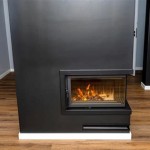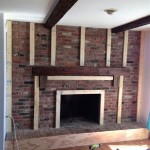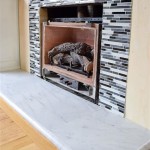How To Build An Oak Fireplace Mantel
An oak fireplace mantel serves as a compelling focal point within a room, enhancing both the aesthetic appeal and perceived value of the fireplace. Constructing one requires careful planning, precise execution, and a foundational understanding of woodworking techniques. The following guidelines outline the process, enabling the creation of a durable and visually striking oak mantel.
Prior to commencing any physical work, meticulous planning is essential. This includes accurately measuring the fireplace opening and surrounding wall space to determine the desired mantel dimensions. Consider the existing architectural style of the room and the fireplace itself. The mantel’s design should complement the overall aesthetic, whether it be traditional, contemporary, or rustic. A detailed sketch or CAD (Computer-Aided Design) drawing is highly recommended, specifying all dimensions, joinery methods, and finishing details. This initial planning phase minimizes errors and ensures a cohesive final product.
Selecting the appropriate oak lumber is critical. Oak comes in various species, each with distinct grain patterns and hardness. Red oak is generally more porous and takes stain readily, while white oak is denser and more water-resistant. Choose the oak species that best suits the desired aesthetic and functional requirements. Furthermore, the lumber should be kiln-dried to minimize warping or cracking after installation. Inspect each board for knots, blemishes, and other imperfections. Purchase lumber that is slightly oversized to allow for trimming and adjustments during the construction process.
Material Acquisition and Tool Preparation
The successful construction of an oak fireplace mantel hinges on having the correct materials and tools readily available. Beyond the oak lumber, consider the necessary fasteners, adhesives, and finishing products. High-quality wood glue, screws, and potentially dowels or biscuits are essential for creating strong and lasting joints. The choice of finish depends on the desired aesthetic, ranging from clear polyurethane to tinted stains and varnishes. Gathering all materials before starting the project streamlines the workflow and minimizes interruptions.
A well-equipped workshop is paramount. Essential tools include a table saw, miter saw, planer, jointer (optional but highly recommended for preparing rough lumber), router, sander, drill, and various hand tools such as chisels, measuring tapes, squares, and clamps. Ensure all power tools are in good working order, with sharp blades and accurate settings. Safety equipment, including eye protection, hearing protection, and a dust mask, are absolutely necessary. Proper tool maintenance and safe operating practices are crucial for preventing accidents and ensuring a successful outcome.
Once the lumber is selected and the tools are prepared, the process of milling the oak to the required dimensions begins. If raw lumber is used, the initial step involves jointing one face and one edge to create perfectly flat and perpendicular surfaces. A planer is then used to bring the opposite face parallel to the jointed face. Finally, the lumber is ripped to the desired width using a table saw. Precision in this milling stage is paramount, as it directly impacts the accuracy and quality of the final mantel.
Following milling, the individual components of the mantel can be cut to their final lengths using a miter saw. Accuracy is again crucial, particularly when cutting miters or other angled joints. If the design incorporates intricate details or moldings, these can be fabricated using a router and appropriate router bits. Exercise caution when operating power tools, and always follow the manufacturer's safety guidelines.
Assembly Techniques and Joinery
The method of joining the oak pieces together significantly impacts the mantel’s structural integrity and aesthetic appeal. Several joinery techniques are suitable, each with its own advantages and disadvantages. Butt joints, while simple, are the weakest and should be avoided unless reinforced with screws and glue. Miter joints, commonly used for corners, provide a clean and seamless appearance but require precise cutting and clamping for a strong bond. More advanced joinery techniques include mortise and tenon joints, dovetail joints, and biscuit joints. Mortise and tenon joints offer exceptional strength and durability, while dovetail joints are renowned for their aesthetic appeal and resistance to pulling forces. Biscuit joints provide a quick and effective method for aligning and reinforcing butt joints.
Regardless of the chosen joinery method, careful attention to detail is essential. Ensure all mating surfaces are clean, smooth, and free of debris. Apply a generous amount of high-quality wood glue to all joint surfaces before assembling the pieces. Use clamps to apply even pressure to the joints while the glue dries. Allow ample drying time, typically 24 hours, before removing the clamps. This ensures a strong and lasting bond.
After the glue has dried, the mantel can be further strengthened with screws. Countersink the screw heads to allow for filling with wood putty later. Avoid driving screws too close to the edges of the wood, as this can cause splitting. Once the assembly is complete, inspect all joints for any gaps or imperfections. Fill any gaps with wood putty or wood filler, allowing it to dry completely before sanding.
Once the mantel is assembled and the joinery is completed, the focus shifts to sanding and finishing. Sanding prepares the surface for the finish, creating a smooth and even substrate. Begin with a coarse grit sandpaper (e.g., 80-grit) to remove any imperfections or machining marks. Gradually progress to finer grits (e.g., 120-grit, 180-grit, and finally 220-grit) to achieve a silky smooth surface. Use a sanding block or orbital sander to ensure even pressure and avoid creating swirl marks. Thoroughly remove all sanding dust with a vacuum cleaner and tack cloth before applying the finish.
Finishing and Installation
The choice of finish drastically impacts the appearance and durability of the oak mantel. Options include clear finishes such as polyurethane or lacquer, which enhance the natural grain of the wood, and stains, which add color and depth. Before applying any finish, test it on a scrap piece of oak to ensure the desired color and effect are achieved. Always follow the manufacturer's instructions for application and drying times. Multiple coats of finish are typically required, with light sanding between each coat to ensure a smooth and even surface.
Prior to installation, precisely locate and mark the desired position of the mantel on the fireplace wall. Use a level to ensure the mantel is perfectly horizontal. Depending on the weight of the mantel and the construction of the wall, various methods can be used for mounting. For lighter mantels, heavy-duty construction adhesive may suffice. For heavier mantels, it is recommended to use screws or bolts to secure the mantel to wall studs or a concrete wall. If attaching to studs, use a stud finder to locate the studs and pre-drill pilot holes through the mantel and into the studs. Use lag screws or long wood screws to securely attach the mantel. If attaching to a concrete wall, use masonry anchors or concrete screws.
Consider creating a French cleat hanging system. A French cleat involves attaching a beveled piece of wood to the back of the mantel and a matching piece to the wall. The mantel then simply slides down onto the cleat, providing a secure and concealed mounting system. This method is particularly useful for heavier mantels, as it distributes the weight evenly. When installing the mantel, ensure it is level and securely fastened to the wall. Double-check the alignment and stability before considering the installation complete.
Finally, after the mantel is securely installed, conduct a thorough inspection. Check for any gaps between the mantel and the wall. If necessary, apply a bead of caulk along the top edge of the mantel to seal any gaps and prevent drafts. Clean the mantel with a soft cloth to remove any dust or fingerprints. The completed oak fireplace mantel adds a touch of elegance and warmth to the room, serving as a functional and aesthetically pleasing addition to the fireplace.

Diy Rustic Fireplace Mantel The Cure For A Boring

How To Make An Easy Diy Fireplace Mantel Sprucing Up Mamahood

Diy Wood Beam Mantel

Easy Diy Fireplace Mantel Tutorial Jessica Welling Interiors

How To Make A Wood Beam Fireplace Mantel

Diy Wood Mantel Simple To Make Artsy Rule
:max_bytes(150000):strip_icc()/remodelaholic-6ed1d077bb0744c5ae6f656273fbc540.jpg?strip=all)
17 Diy Fireplace Mantel Plans
:max_bytes(150000):strip_icc()/ablossominglife-4151b41015a64193a437e981c3aad037.jpg?strip=all)
17 Diy Fireplace Mantel Plans

Diy Fireplace Mantel And Surround Jenna Kate At Home

Diy Rustic Fireplace Mantel The Cure For A Boring
Related Posts








